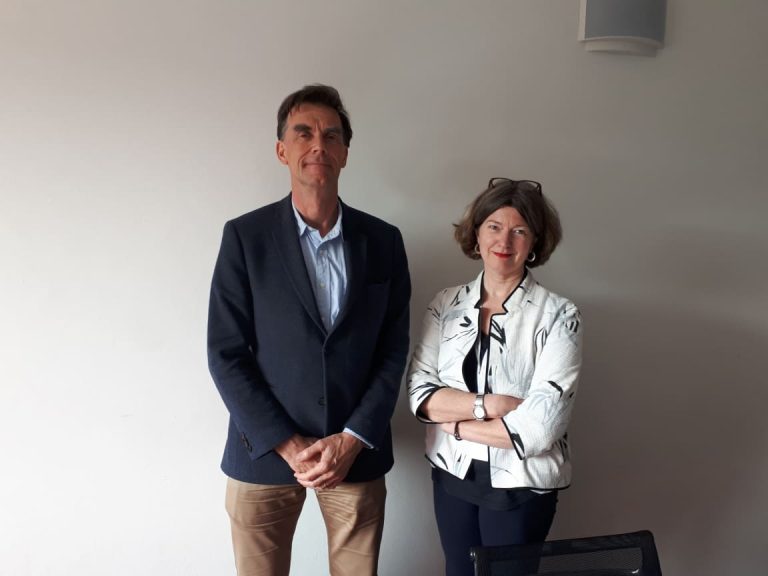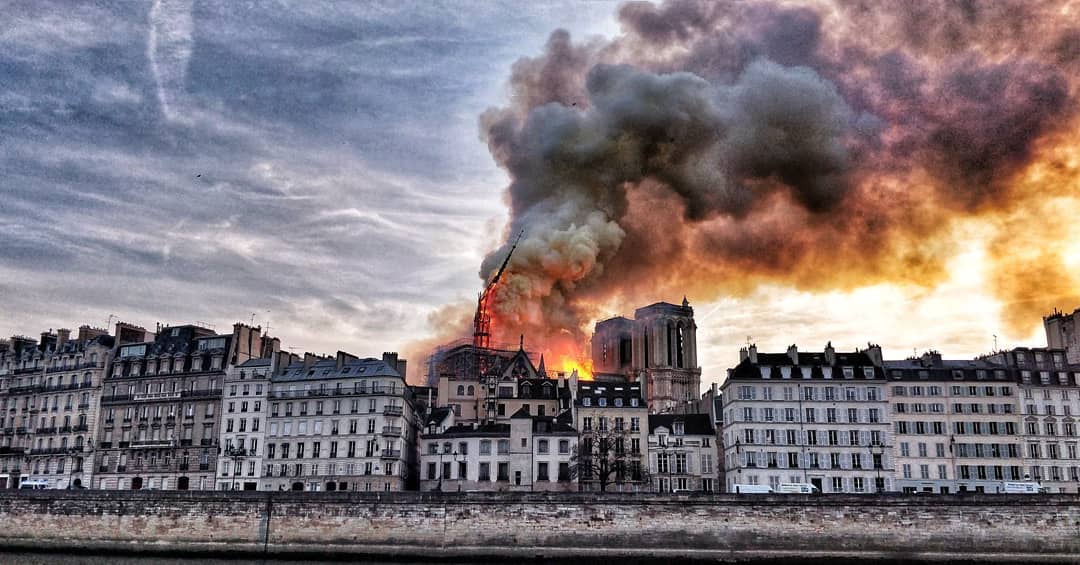“The Notre-Dame can be rebuilt and open a new chapter for co-creation for European society,” say TU Delft Professor Uta Pottgiesser and Assistant Professor Frank Koopman.
What will it be of Notre-Dame? (Photo: @annakaminova | Twitter)
The 15th of April 2019 will go down in history as the night of the Notre Dame de Paris fire. The world’s eyes were glued on the Cathedral as a massive blaze ravaged one of humanity’s most well-known Gothic architectural wonders. The firefighters’ efforts conquered the fire and saved the church, but France’s heart will take a long time to heal. To discuss how Europe can recover from such a tragedy, Delta contacted Professor Uta Pottgiesser, Chair of the Heritage + Technology department AE + T or TU Delft’s Architecture Faculty, and Assistant Professor Frank Koopman, from the same department, to address the topic.


Can the Cathedral be restored to its former glory?
Pottgiesser: “If we talk about values, probably it can. But the focus lies on understanding how Notre Dame Cathedral can be reconstructed. It has to be determined if the reconstruction would mean using the same materials, constructions and design or choosing a different approach. ”
Koopman: “Part of its former glory on the old materials, but the wooden structure seems to have been lost among the flames. That glory is gone. We can reconstruct the Cathedral, but we can never get some of the original parts back. It is a pity. “
Does the cultural significance of the building impede the reconstruction of the cathedral?
Koopman: “No, but there will be lots of different stakeholders and it will be a challenge to align so many. It will take time and patience to understand the situation and take the best decision for Notre-Dame. ”
Pottgiesser: “This event proves that the building has a high cultural significance and is much more than just a church. It is a symbol of French history. A tourist attraction for more than 13 million tourists a year. A landmark of major urban significance – as a world heritage site, it’s one of the buildings on the Banks of the Seine. Any reconstruction must take these manifold significant values into account. Once these are agreed, the discussion on design, building techniques and the time required can begin. ”
Do you think it’s appropriate to show the marks of the fire or to restore it as if nothing happened?
Pottgiesser: “You should show the passage of time. No historical church in the world ignores it. Historically, most churches display different periods on their walls and structures. Every monument church took decades, if not centuries, to build. The Cologne Dome is a notable example as it was started in 1248 and finished at the end of the 19th century. Notre Dame itself took more than 100 years to finish. Only new churches are built in one or two years. “
Koopman: “The Cathedral has already undergone several restorations in the past. All these restorations and changes are part of history and of the Cathedral. You don’t want to show an idealized portrait or a certain era, you want to portray its history. ”
Pottgiesser responds: “In addition, there are different approaches for the renovation. Notre-Dame is famous because it was one of the first Eugéne Viollet-le-Duc’s renowned renovation works , which took place from 1845 to 1864. By adopting a more traditional approach, the referred back to medieval constructions. Nowadays, we have many more approaches which have been practiced in several different churches. Some examples of traditional methods are the Frauenkirche in Dresden and Piazza San Marco in Venice. There are also memorials like the Kaiser Wilhelm Memorial Church in Berlin that was badly damaged during World War II and not restored to show the marks of war. The restoration depends on how stakeholders’ deal with this incident. “
“These walls are dangerous”
What should happen now?
Koopman: “Safety first! An extensive survey of the situation is mandatory — experts must check if the remaining parts are safe to enter and can be kept as they are. Some of the remnants of the walls are no longer connected to the roof and have become unstable. These walls are dangerous. Another issue is the scaffolding, which was placed there for the ongoing renovation work. It is now hanging in the air above the church. Somehow, it has to be removed. There are lots of urgent upcoming challenges.”
Pottgiesser: “Another question is how much time is required. If the safety measures that Frank mentioned are taken, a temporary roof must be built to protect the interior from getting wet and deteriorating. Then, the next question is how long these temporary structures can stay? In many cases, temporary constructions become permanent features for a period of time. Besides, there should be greater participation in the process. Experts should discuss the Cathedral’s value for Paris, the French people and the world — we need a public participation process, to understand the values that people associate with the cathedral. Perhaps the building will be adapted to new requirements. Before the fire, UNESCO documented a high risk of potential structural damage from wind loads. Any future work should improve these technical requirements.”
The fire started during renovation work — do you have any inkling of what may have happened?
Koopman: “It could be lots of things. We have examples of fires that started during renovation work from welding pipes for plumbing. We have to wait for the report to know what happened. Otherwise, it’s just speculation.”
Pottgiesser: “I agree and I have to say that it was dreadful to see that it took almost one hour for the firefighters to arrive on the spot. It was rush hour and the firefighters had to cross all the bridges over the Seine to reach the island where the Cathedral is. For burning wooden materials, a delay like this is a disaster.”
How much time would it take and how much do you think it’s going to cost?
Pottgiesser: “Before the fire, experts said it would cost EUR 150 million alone for essential structural work to the Cathedral. It’s impossible to say at the moment — it depends on the extent of the damage, the techniques and the materials used. If you want to craft it in the traditional design, there may not even be enough people available in a short space of time. That adds additional challenges.”
Koopman: “The construction took more than 100 years and there was a reason for that: the availability of materials and craftsmen. We have the same problem today. For the roof construction alone, workers cleared around 13,000 oak trees, only using trees of 300 to 400 years old. We do not have the right to fell that number of trees now. The sheer availability of materials is a huge problem. It is possible to do that, but stakeholders need to consider the time needed and the cost of having that material available. That could be a reason to spread the construction across decades.”
Pottgiesser: “There are also ethical, aesthetic and design decisions. Are we prepared to take them? Do we want to fell so many trees? Do we want to plant them and then wait, or do we go with another construction? The Archaeological Museum of Frankfurt opted to rebuild using a lightweight steel structure. Another option is to use alternative structural systems and lighter materials that are now available in this time of circularity. These different options have to be evaluated.”
‘A big movement is starting’
What can this event teach us?
Koopman: “It is surprising to see how many emotions the cathedral has evoked around the world. In a time when people are leaving churches, it is fascinating to see how many people have a connection with Notre-Dame. I find that surprising. Lots of people from different classes and backgrounds started to collect and donate money for the renovation. A big movement is starting.”
Pottgiesser: “On the other hand, this again reflects the discussion on values. It’s more than a church. It can be seen as part of the collective memory, something that people think belongs to Paris. It shows that behind buildings are meanings.”
Koopman: “The French President, Emmanuel Macron, already declared that it will be rebuilt and that a lot of money, even hundreds of millions of euros have been raised overnight. It is ironic given that there were problems raising enough money for the ongoing renovations which started in April.”
Pottgiesser: “There is also a political dimension. We could lose something that we never imagined we could lose. With the current political situation in France, politicians have immediately taken the initiative to reconstruct one of France’s most important symbols — it is a gesture with a unifying force. It goes beyond architectural heritage and it shows the intangible aspects of a building.”
Koopman: “There is an interesting parallel with TU Delft’s Faculty of Architecture. In 2007, I was in the old Architecture building when it caught fire. After the fire, there was such a huge amount of energy to rebuild the Faculty. Now people seem prouder of this building than its predecessor. The incident shows that good things can come from tragic events. You don’t want to happen, but if it does, you should try to see the positive side. ”
Pottgiesser: “In Western societies, the hot topic is participation and co-creation. This has always been a tradition in urban planning, and it emerged in all architecture disciplines. We need to investigate how the population, the planners and the designers can help each other. If that happens, we have a solid base to build on. Notre-Dame could become a notable example of a high-ranking co-created building known and shared by everyone. It could be a showcase for how such a process can work in the 21st century. ”
Davide Zanon / Science Editor trainee



Comments are closed.